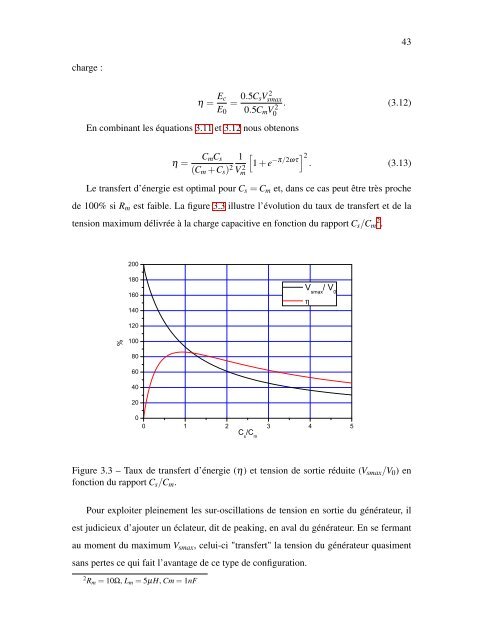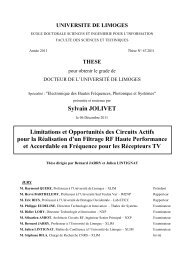Etude et conception d'un étage de mise en forme d'impulsions ultra ...
Etude et conception d'un étage de mise en forme d'impulsions ultra ...
Etude et conception d'un étage de mise en forme d'impulsions ultra ...
Create successful ePaper yourself
Turn your PDF publications into a flip-book with our unique Google optimized e-Paper software.
charge :<br />
η = Ec<br />
=<br />
E0<br />
0.5CsV 2<br />
smax<br />
0.5CmV 2 0<br />
En combinant les équations 3.11 <strong>et</strong> 3.12 nous obt<strong>en</strong>ons<br />
η = CmCs<br />
(Cm +Cs) 2<br />
1<br />
V 2 m<br />
43<br />
. (3.12)<br />
<br />
1 + e −π/2ωτ 2<br />
. (3.13)<br />
Le transfert d’énergie est optimal pour Cs = Cm <strong>et</strong>, dans ce cas peut être très proche<br />
<strong>de</strong> 100% si Rm est faible. La figure 3.3 illustre l’évolution du taux <strong>de</strong> transfert <strong>et</strong> <strong>de</strong> la<br />
t<strong>en</strong>sion maximum délivrée à la charge capacitive <strong>en</strong> fonction du rapport Cs/Cm 2 .<br />
%<br />
2 0 0<br />
1 8 0<br />
1 6 0<br />
1 4 0<br />
1 2 0<br />
1 0 0<br />
8 0<br />
6 0<br />
4 0<br />
2 0<br />
0<br />
V s m a x / V 0<br />
0 1 2 3 4 5<br />
C /C s m<br />
Figure 3.3 – Taux <strong>de</strong> transfert d’énergie (η) <strong>et</strong> t<strong>en</strong>sion <strong>de</strong> sortie réduite (Vsmax/V0) <strong>en</strong><br />
fonction du rapport Cs/Cm.<br />
Pour exploiter pleinem<strong>en</strong>t les sur-oscillations <strong>de</strong> t<strong>en</strong>sion <strong>en</strong> sortie du générateur, il<br />
est judicieux d’ajouter un éclateur, dit <strong>de</strong> peaking, <strong>en</strong> aval du générateur. En se fermant<br />
au mom<strong>en</strong>t du maximum Vsmax, celui-ci "transfert" la t<strong>en</strong>sion du générateur quasim<strong>en</strong>t<br />
sans pertes ce qui fait l’avantage <strong>de</strong> ce type <strong>de</strong> configuration.<br />
2 Rm = 10Ω, Lm = 5µH, Cm = 1nF<br />
η

















